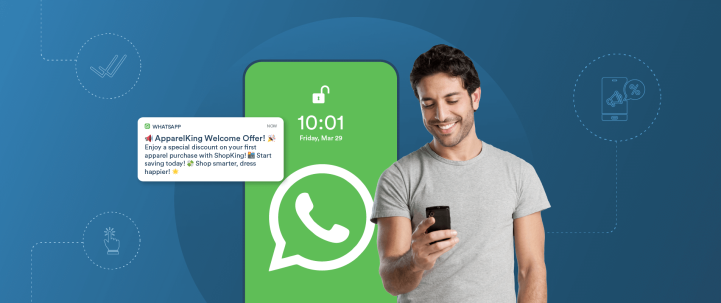In an effort to prioritize relevance and quality interactions, WhatsApp recently introduced marketing message limits in India, altering the landscape for businesses seeking to effectively engage their audiences via WhatsApp. This significant development challenges brands to rethink their strategies and adapt to the new constraints. In this comprehensive guide, we’ll delve into the implications of these changes, explore strategies to navigate the limits and provide actionable insights to ensure continued engagement with your audience.
Understanding the Changes
Under the new guidelines, each WhatsApp user will have a predetermined limit on the number of marketing messages he receives within a given period from any business, and not just from your business. Moreover, WhatsApp will select the brands based on metrics such as their read rates, engagement levels, etc. and will keep adjusting these limits occasionally, and you will have to stay sharp and be even more mindful of your WhatsApp marketing.
Before we dive into the strategies to navigate these changes, here is a brief overview of what’s changed:
- Limits on Marketing Messages: WhatsApp will restrict the number of marketing template messages a user can receive, aiming to prioritize high-quality and relevant engagements.
- Exemption for Ongoing Conversations: If you already have an open marketing conversation with a user, messages sent within that conversation will not be affected by this limit.
- Error Codes for Blocked Messages: If a marketing message exceeds this limit, it may not be delivered, and Meta will send an error code (Cloud API: 131026, On-Premises API: 1026). These codes indicate potential delivery issues but will not specify the exact reason for non-delivery. CleverTap customers can monitor this error labeled as ‘Recipient phone number invalid’.
- No Charges for Blocked Messages: Importantly, businesses will not be charged for messages that are blocked due to these limits.
Implications for Businesses
WhatsApp’s decision to impose per-user limits on marketing template messages carries profound implications for businesses across India. Firstly, it necessitates a fundamental reassessment of existing communication strategies. With users now receiving a finite number of messages, brands must recalibrate their approach to prioritize quality over quantity. This shift demands a nuanced understanding of user preferences and behavior to deliver messages that resonate deeply and drive meaningful interactions.
Brands must strive to deliver value-driven content that captures attention and elicits a response from users. Failure to do so risks relegation to the sidelines, as users increasingly gravitate towards brands that offer personalized, engaging experiences. Non-compliance not only jeopardizes message delivery but also erodes user trust and brand credibility. In essence, the implications of WhatsApp’s new marketing message limits extend far beyond mere compliance. They herald a new era of digital engagement, where success hinges on a brand’s ability to deliver value, foster meaningful connections, and adapt to evolving user expectations.
Strategies to Navigate the Changes
Navigating WhatsApp’s new marketing message limits requires strategic adaptation to ensure continued engagement with your audience. Here are actionable strategies to effectively navigate these changes and maintain meaningful interactions with your customers.
Improve Engagement
Leverage Interactive Content: Engage your audience with interactive elements such as polls, surveys, and quizzes embedded within your messages.
Offer Exclusive Deals via WhatsApp: Incentivize engagement by offering exclusive discounts, promotions, or sneak peeks through WhatsApp.
Implement Autoresponders: Streamline customer interactions by implementing automated responses to common queries or requests.
Optimize Your Engagement Strategy: No more mass blasts without A/B testing or, better yet, leveraging AI-powered experimentation that enables real-time multifaceted testing to identify the best-performing content, time, and channel for engagement at any given time.
Create More Contextual Interactions
Harness the Power of Personalization: Utilize advanced segmentation to deliver personalized messages tailored to each user’s preferences and behavior.
Adopt an Omni-Channel Approach: Engage based on customer preferences and not based on channel capabilities. Diversifying your engagement strategy with channels like Email, SMS, Push, and more for disengaged users on WhatsApp for sustained user engagement levels.
Leverage Event-Triggered Messaging: Capitalize on user actions and behaviors to trigger timely and relevant messages.
Respect User Preferences
Empower Users with Subscription Options: Respect user preferences by providing clear opt-in and opt-out options for marketing messages.
Apply Frequency Caps: Set limits on the frequency of messages to prevent over-messaging and mitigate the risk of user fatigue.
Pro Tip: Troubleshooting WhatsApp Test Notification Deliverability Affected by Policy Change
If you are encountering delivery issues while internally testing your WhatsApp notifications on your team member’s phones, whether it’s before scheduling campaigns or during integration, here’s a handy guide to ensure your test messages reach their intended recipients:
Using Utility Templates for Delivery Checks: For verifying message delivery, consider using utility templates. These templates are typically less restricted and offer a clear indication of your messaging infrastructure’s functionality, free from the constraints that might affect marketing messages.
Testing Marketing Messages: If your marketing message fails to deliver despite successful dispatch from your WhatsApp business number, follow these steps:
- Initiate a conversation from the device you use for testing by sending a message to your WhatsApp business number.
- After sending the message, attempt to resend your test marketing message.
Conclusion
WhatsApp’s new marketing message limits pose a challenge for businesses, but they also present an opportunity to innovate and refine engagement strategies. By embracing creativity, personalization, and technology, you can navigate these changes successfully and continue to deliver value to their audience. Remember, the key to effective engagement lies in delivering relevant and meaningful messages that resonate with your audience’s needs and preferences.
Deepak Yadav 
With over 5 years of experience as a Product Manager at CleverTap, Deepak Yadav has successfully led technical accounts, managed global support, and driven growth at Fynd and Paintcollar.
Free Customer Engagement Guides
Join our newsletter for actionable tips and proven strategies to grow your business and engage your customers.















































